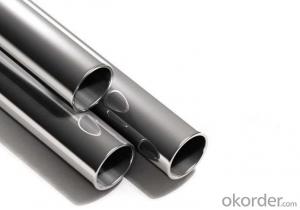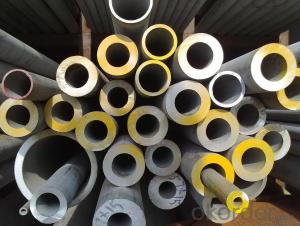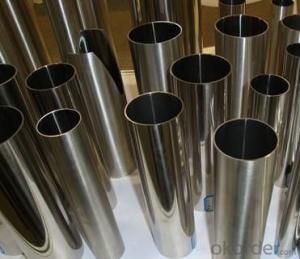304 Stainless Steel Pipe
- Loading Port:
- China main port
- Payment Terms:
- TT OR LC
- Min Order Qty:
- 5 m.t.
- Supply Capability:
- 100000 m.t./month
OKorder Service Pledge
OKorder Financial Service
You Might Also Like

304 stainless steel pipe price list
Our Advantages
You can get a competitive price with high quality.
We can provide sample for your evaluation.
We can provide Mill test certificate.
Your enquiry will get quickist and efficient response.
Introduction of grade 304
304 stainless steel material is a kind of common stainless steel materials, corrosion prevention is better than 200 series stainless steel materials. High resistance to high temperature is also better, it can reach to 1000-1200 degrees. 304 stainless steel has good corrosion,corrosion resistance and good resistance to intergranular corrosion. For oxidizing acid, obtained in the experiment, the concentration of 65% or less under the boiling temperature of nitric acid, 304 stainless steel has a strong corrosion resistance. To most organic and inorganic acid and alkali solution with good corrosion resistance ability.
Physical properties
Tensile strength σb (MPa): 520
Conditions yield strength 0.2 sigma (MPa) :205
Elongation δ5 (%) :40
Section shrinkage ψ (%): 60
Hardness: ≤187HB ≤90HRB≤200HV
Some details of our products
| Product: | 304 stainless steel pipe price list |
| Grade: | 304; sus304; 1.4301; |
| Standard: | ASTM,AISI,JIS,EN,DIN,GB |
| Surface treatment: | 8k, ba, hl |
| Thickness: | 0.4-30mm |
| Outer Diameter | 20-400mm |
| Productivity: | 900MT/Month |
| Products range | hot rolled stainless steel sheet, hot rolled stainless steel coil, hot rolled flat steel,cold rolled stainless steel sheet, cold rolled stainless steel coil, Industrial tube, decorative tube |
Trade terms
| Product | 304 stainless steel pipe price list |
| MOQ: | 5 Ton |
| Payment Term: | 1. 30%T/T in advance ,the balance against the B/L copy 2. 30%T/T in advance ,the balance against the L/C at sight 3. 100%L/C at sight |
| Price Term: | FOB/CFR/CIF |
| Delivery: | 1.10 days after receiving the deposit of T/T 2.10 days after receiving the L/C original |
| Packaging: | Standard Export Packing |


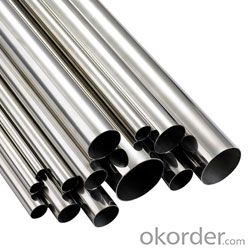
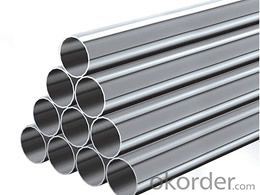
- Q:Can stainless steel pipes be pickled and passivated?
- Yes, stainless steel pipes can be pickled and passivated. Pickling is a process that removes impurities and scale from the surface of stainless steel, while passivation is a treatment that forms a protective oxide layer on the surface to enhance corrosion resistance. This process is commonly used in industries such as oil and gas, chemical, and food processing to ensure the cleanliness and longevity of stainless steel pipes. Pickling and passivation can be done using a variety of acidic solutions and techniques, depending on the specific requirements of the pipes and the desired outcome.
- Q:What are the connecting methods of stainless steel pipes for indoor water pipes?
- Card type features: easy to install, connecting the external pipe, the internal rubber ring is evenly compressed into hexagonal. Scope of application: cold water system, pipe direct drinking water system, and more suitable for pipe installation. The utility model has the advantages that the connection is simple and convenient, the working hours are short, and the cost is moderate. Drawback is the single application, the maintenance of trouble, both the pipe sealing ring in aging and need to be replaced more trouble, because the connection was stuck, replacement is the need to both ends of the pipe to replace the sawing.
- Q:Are stainless steel pipes resistant to chloride stress corrosion cracking?
- Generally, stainless steel pipes resist chloride stress corrosion cracking. Stainless steel is well-known for its ability to resist corrosion, even in chloride environments. The presence of chromium in stainless steel creates a protective layer on the surface that shields it from corrosion. This layer stops chloride ions from penetrating and reduces the risk of stress corrosion cracking. However, the resistance to chloride stress corrosion cracking can vary depending on the particular grade of stainless steel and the surrounding conditions. Therefore, it is crucial to select the appropriate stainless steel grade that offers sufficient resistance to chloride stress corrosion cracking for specific applications, particularly in high chloride environments like coastal areas or industrial settings.
- Q:How do you calculate the required support spacing for stainless steel pipes?
- Several factors must be taken into account when calculating the necessary support spacing for stainless steel pipes. These factors encompass the pipe diameter, the weight of the material, the system's temperature, the fluid flowing through the pipe, and the desired safety factor. The initial step involves determining the pipe diameter. This can be achieved by direct measurement or by calculating it using the pipe's schedule and nominal size. Once the diameter is known, the weight of the stainless steel pipe per unit length can be determined using the density of stainless steel. Afterwards, the temperature of the system in which the pipe will operate must be considered. Stainless steel pipes can expand and contract with temperature changes, and this thermal expansion must be taken into account when determining support spacing. The thermal expansion coefficient of stainless steel can be utilized to calculate the expected expansion across the temperature range. The fluid flowing through the pipe should also be taken into consideration. If the fluid is corrosive or possesses high velocity or pressure, additional supports may be necessary to prevent excessive vibration or stress on the pipe. Finally, the desired safety factor must be incorporated. This factor represents the additional support spacing required to ensure the integrity and stability of the pipe system. Common safety factors typically range from 1.5 to 3, depending on the specific application and industry standards. Once all these factors are known, various industry standards and guidelines can be employed to calculate the required support spacing for stainless steel pipes. These standards provide formulas and tables that consider the aforementioned factors, enabling engineers and designers to determine the appropriate distance between pipe supports. It is important to note that qualified professionals with knowledge of industry standards and local regulations should perform these calculations to ensure the safe and efficient operation of the stainless steel pipe system.
- Q:Can stainless steel pipes be used for compressed air systems?
- Indeed, it is possible to utilize stainless steel pipes for compressed air systems. Thanks to their remarkable resistance to corrosion, stainless steel pipes are well-suited for scenarios involving compressed air. They possess the ability to withstand substantial pressure levels, guaranteeing dependable and leakage-free functionality. Furthermore, stainless steel pipes exhibit durability and longevity, assuring the continued efficiency and functionality of the compressed air system. Nevertheless, it is crucial to carefully assess the particular demands of the compressed air system and seek guidance from experts to ensure proper sizing and installation of the stainless steel pipes to meet the system's requirements.
- Q:Water and electricity thin wall stainless steel tube 304 material delta 2 what does that mean?
- 304 is a stainless steel number, 2.9 refers to the pipe wall thickness.
- Q:What is the difference between seamless and hot-expanded stainless steel pipes?
- The main difference between seamless and hot-expanded stainless steel pipes lies in their manufacturing processes. Seamless pipes are created by piercing a solid billet of stainless steel, while hot-expanded pipes are made by expanding a hollow tube while it is heated. This process results in a larger diameter and thinner wall thickness compared to seamless pipes. Additionally, hot-expanding allows for a wider range of sizes and shapes to be produced.
- Q:How can galvanized steel pipe be connected with stainless steel pipe?
- Welding flanges respectively, with flange connection, but galvanized pipe according to specifications, dynamic welding after two times galvanized,
- Q:Can stainless steel pipes be wrapped with fiberglass insulation?
- Indeed, fiberglass insulation can be applied to stainless steel pipes. It is a frequently employed method for insulating diverse pipe varieties, including stainless steel ones. By doing so, it aids in diminishing heat loss and preserving the pipe's temperature, hence enhancing its energy efficiency. Moreover, fiberglass insulation also offers advantages such as soundproofing and condensation management. To attain optimal insulation performance and achieve utmost energy conservation, it is imperative to correctly install and seal the fiberglass insulation around the stainless steel pipes, thus eliminating any gaps or air leakage.
- Q:What is the density of stainless steel pipes?
- Depending on the specific grade of stainless steel, the density of stainless steel pipes may differ. Nevertheless, stainless steel pipes typically have a density range of 7.9 to 8.0 grams per cubic centimeter (g/cm³). Compared to other materials, this density is relatively high, which enhances the strength and durability of stainless steel pipes.
1. Manufacturer Overview |
|
|---|---|
| Location | |
| Year Established | |
| Annual Output Value | |
| Main Markets | |
| Company Certifications | |
2. Manufacturer Certificates |
|
|---|---|
| a) Certification Name | |
| Range | |
| Reference | |
| Validity Period | |
3. Manufacturer Capability |
|
|---|---|
| a)Trade Capacity | |
| Nearest Port | |
| Export Percentage | |
| No.of Employees in Trade Department | |
| Language Spoken: | |
| b)Factory Information | |
| Factory Size: | |
| No. of Production Lines | |
| Contract Manufacturing | |
| Product Price Range | |
Send your message to us
304 Stainless Steel Pipe
- Loading Port:
- China main port
- Payment Terms:
- TT OR LC
- Min Order Qty:
- 5 m.t.
- Supply Capability:
- 100000 m.t./month
OKorder Service Pledge
OKorder Financial Service
Similar products
New products
Hot products
Hot Searches
Related keywords


